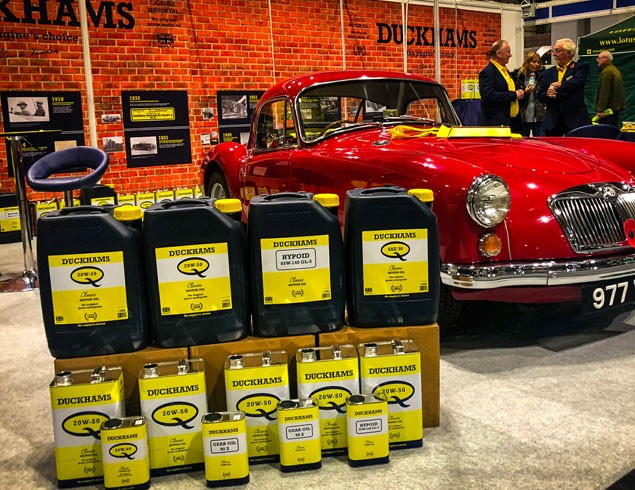 Read more
Read more
Duckhams On One Of The UK’s Oldest And Most Gruelling Motorsport Events
Our PR Manager, Wayne Scott takes on the 2019 Exeter Trial in a TR7 V8 to put Duckhams Classic Q20W 50 to the ultimate test.
The Exeter Trial, run by the Motorcycle Club Limited (MCC) is one of the world’s oldest motorsport events and has been running since 1910, interrupted only by a couple of World Wars. There are three hundred entrants each year, almost evenly split between motorcycles and cars, all attacking the muddiest, rockiest, steepest hills you can imagine.
Each of the hills is referred to as a ‘section’ and there are fourteen in total, spread across a 250-mile route through the Devon countryside. Each team has one driver that pilots the vehicle for the entire seventeen-hour duration alongside a passenger who is there to navigate and occasionally bounce about to assist the car in finding grip.
Teams are awarded according to the number of sections you ‘clear’, which quite simply is achieved by getting to the top without stopping. Easier said than done. Clear all thirteen sections and you claim a Gold Medal, Silver for failing one and a Bronze for failing three. Some of these sections are also known as ‘stoppers’ and the clue’s in the name, these are the hills notorious for being brutal to teams with ambitions of getting up them.
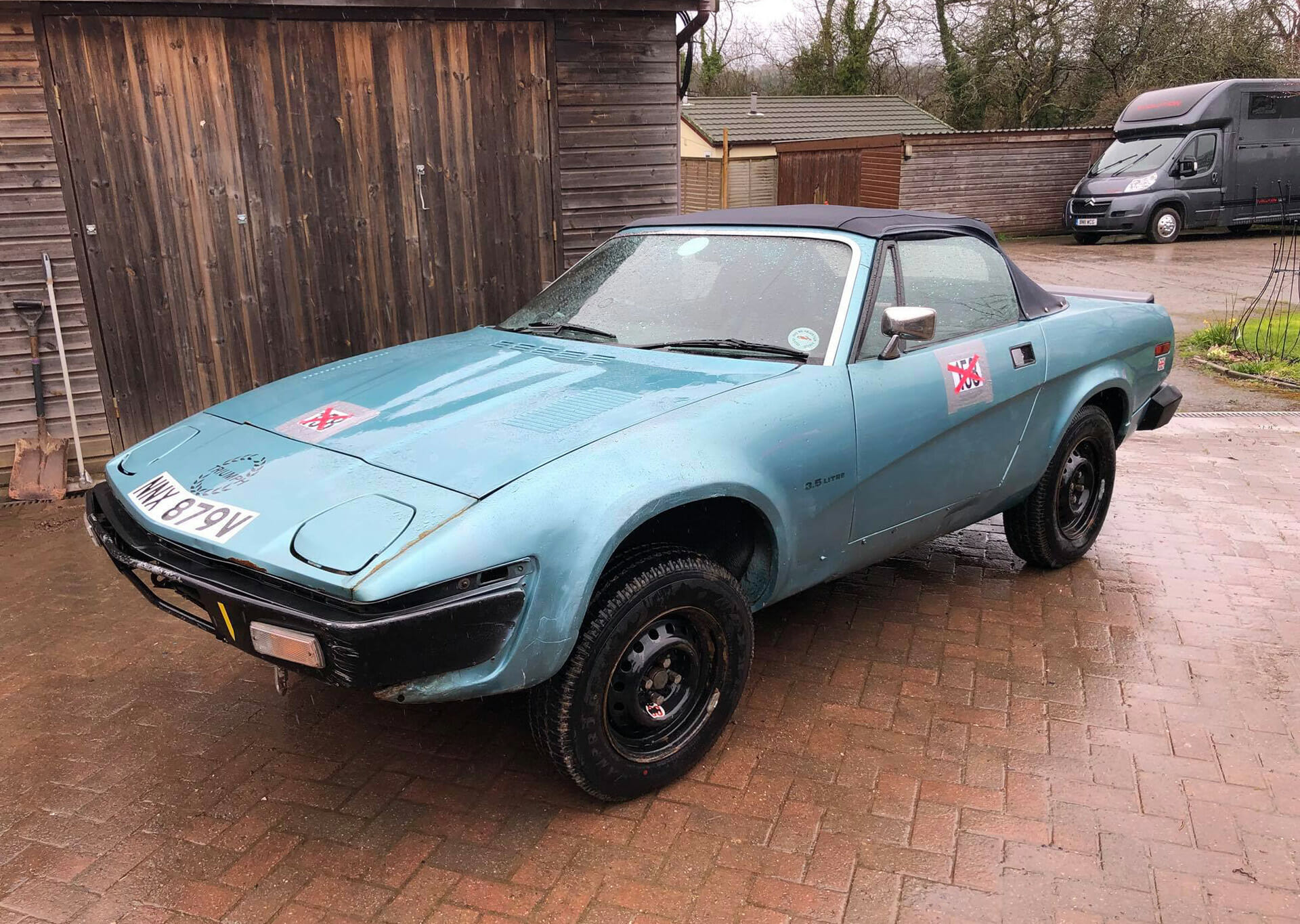
On arrival at our start point, Sourton Cross, a lonely feeling service area just on the A30 near Okehampton, the first challenge is to pass scrutineering. After signing on, you are allocated a start time and exactly to the second, the release marshal drops his flag and the Exeter Trial begins.
The next challenge was a special test, so called because unlike the fourteen sections, these driving tests are against the clock and involve accelerating over a line, stopping astride and reversing maneuvers as instructed by the road book. This first special test was relatively simple, albeit on a very dark gravelly lane but was on the level and with good grip. The special tests however were to get trickier as the trial continued.
Haynes Motor Museum was the next destination, reached by navigating our way through an endless dark black corridor of high hedgerows and twisty lanes synonymous with this part of the country.

Haynes Motor Museum sees crews go through final scrutineering (where fire extinguishers and spill kits are checked for), fill up on hot food from the canteen and have a wander around the exhibits. Then just after 3 am, the Marshalls surrendered our road book, signed us off and we got underway. A checkpoint followed at a Triumph motorcycle dealership before we finally arrived at the first of the sections – and as usual, my pulse rate went sky high.

It is difficult to put across into words just how intimidating the atmosphere is as you approach the start line to your first section. Inevitably with so many competitors, (many of whom will end up failing the section, requiring them to be backed up or in extreme cases towed out) there is a queue that forms. This waiting time in pitch dark forest is not only a chance to adjust tyre pressures but also listen to the deafening roar of engines at full revs wailing in protest through the inky black forest somewhere above your head. Occasionally, in the darkness, you will catch a brief glimpse of some tail lights as they buck and bounce through the gloom or detect the smell of burning clutches wafting through the undergrowth.
Before I knew it, the faint tail lights of Phil’s veteran trials Triumph TR3A disappeared and as the marshal beckoned me forward to take my start position, all fell silent within our TR7V8’s cabin. Even Richard my jovial navigator issued few words of encouragement instead opting to leave me to my thoughts; perhaps he had thoughts of his own.

I have been fortunate to do all sorts of things in cars. Track racing, speed trials, rallying, drifting and even hill climbing. But there is something unique about trialing that really gets the adrenaline flowing. This was my third trial but I was still not quite sure how to approach this first stage, what technique to use or even how quick to go. This is seat of the pants driving for, after all the advice, you can only follow your own gut instincts in the heat of the moment. We let the tyres down, 18PSI seemed to be appropriate. By letting the tyres down, you increase the amount of rubber spreading itself on the slippery surface giving you more grip. However, let them down too much and you run the risk of damaging the wheel on rocks or even ripping the tyre from the rim. Judging the sweet spot is all part of the skills you must learn to become a seasoned trialing pro.
Then it happened, the Marshall dropped his flag and we were off. I was conscious not to spin the wheels up too much on the slimy mud underfoot. Gentle with the clutch, build the momentum. You gather speed quicker than you might imagine in the quagmire and soon a ninety left arrives with a sturdy looking tree that seemingly leaps out of the shadows at you straight ahead. It was all I could do to coax the Triumph TR7V8 around the bend without losing speed, the understeer in the mud is monumental. I have gone in too hot, the car wrenches out of the ruts and is determined to meet with another menacing looking tree. With two wheels on the bank, I manage to find some grip and pull us back into line before squeezing the accelerator as much as I dare to power us forward into the blackness.
There are trees jumping out at you from every side, I was focused on keeping the wheels tracking through the ruts left by previous competitors, fall out and we will get beached. The speed is now building and with it the incline gets steeper. The TR7V8 is sounding glorious though as, at full revs, it is sending pops, bangs and crackles off into the forest. “It sounds like a Gatling gun” remarked one spectator later on. There was enough power though to fire us forward, the car sliding left and right requiring me to frantically saw at the steering wheel, correcting the direction of travel constantly until suddenly the gift of a “Section Ends” board loomed out of the darkness. We had cleared the first section! Just thirteen more to go, and that was an easy one!
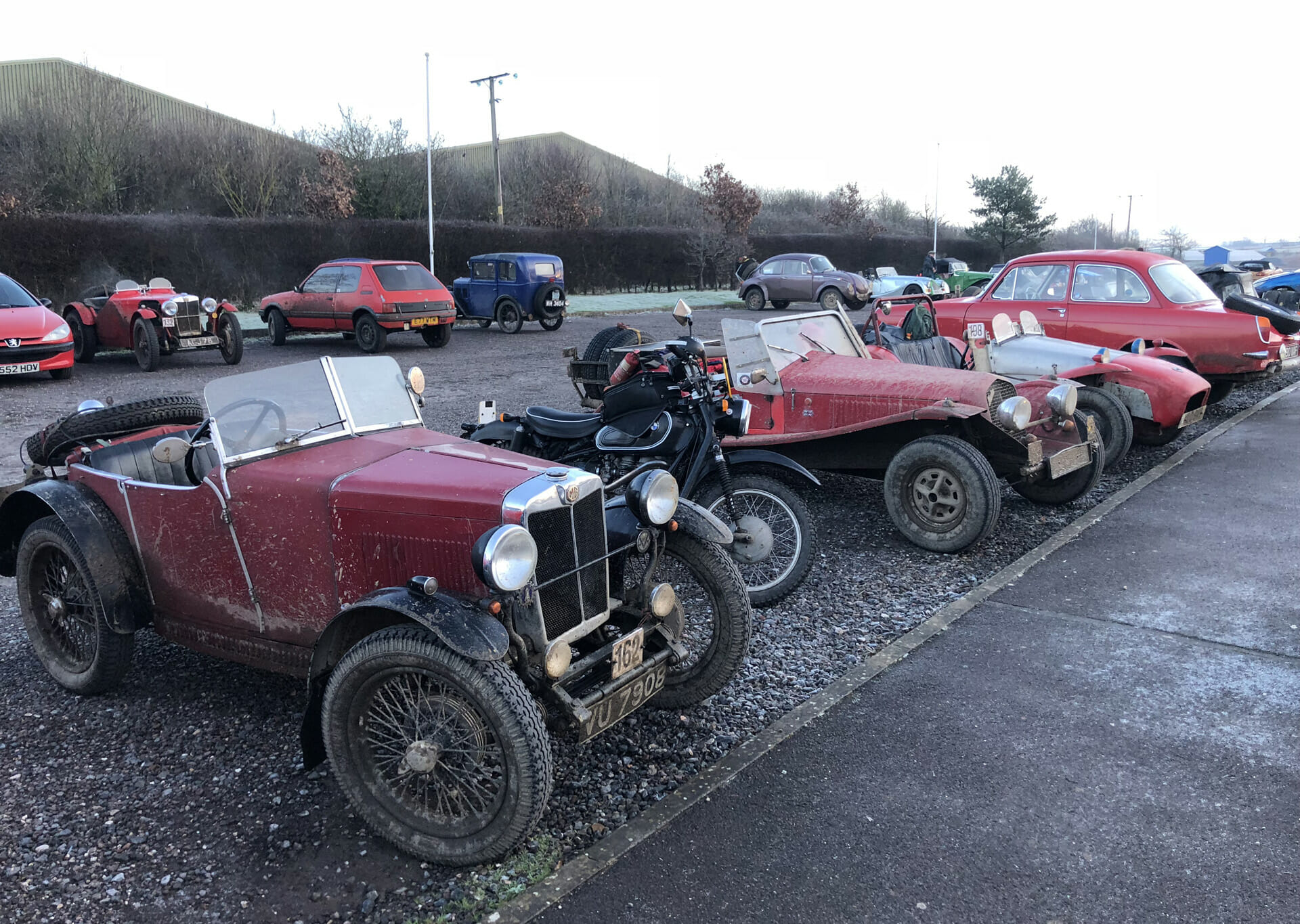
It is worth mentioning at this point, just what goes in to preparing cars for a grueling car killer of an event like this. It is hard to put into words just how far out of its comfort zone a car is when bouncing violently up the rocky side of a Devon slope. This is terrain that a Land Rover would struggle with and here we are throwing a 70s sportscar up the same! Behind us are even more hardier examples of their breed, one such being a 1930s Austin 7 that has taken part in these trials since it was new – seriously impressive! The suspension reaches maximum travel in all directions plus some, so is heavily modified and beefed up. The engine too must have the right amount of power in the right rev range but, most important of all, it MUST be reliable. The engines are run at maximum RPM for minutes at a time. Furthermore, whilst the best measures are taken to prevent the ingress of dirt into the engines, some is inevitable. So, to cope with all this and to ensure trialing success to our wedge-shaped warrior of a Triumph TR7, we were relying on all those Duckhams benefits to keep us protected.
The oil we chose was Duckhams Classic Q20W – 50, no special formulation, just the off-the -shelf version you can buy. It has optimized ZDDP which will form a lovely thick anti-wear coating on the internal faces of the engine to help keep components like new. Oil stabilisers also ensure that it has a high shear resistance, crucial when running at very high engine speeds under load for extended periods of time.

There was little time for celebration after completing our first couple of stages. Navigator Richard and I exchanged meaningful back slaps before we were quickly on the road again and navigating to our next section to do it all over again. Conditions were good and my confidence was beginning to grow for our chances of a medal this year. However, the next section was Norman’s Hump – and it is one of those notorious ‘stoppers’.
This section was steep, really steep. All you can see at 5am are taillights seemingly floating off into the sky. The surface was rocky, loose gravel with big humps and ridges on which a car can easily get beached and loose traction. This section requires a bit of thought, get the first tight right-hand bend wrong and you can end up with your bumper in the bank, you must go wide to get around in one movement, you cannot stop remember. That I managed, controlling with a dab of accelerator here, a dab of clutch there, lifting off to traverse the ridges, rocks and gulleys before catching the momentum the other side to move us forwards consistently. I was beginning to get a feel for the skill involved in this raw unadulterated form of motorsport and it was thrilling. Enthusiasm and adrenalin got the better of me towards the top of Norman’s Hump as once again thrashing left and right correcting the steering I carried too much speed over said ‘Hump of Norman’ and we were airborne briefly. Not wise, the car must last the distance and I had a word with myself not to repeat that mistake again. That mistake proved to be costly though as, although I had cleared the section the year before without incident, this year we ran out of grip just metres before the section end board. Our first penalty.

We quickly moved on to Clinton, Waterloo, Streates to claim another three but a restart at Passaford Lane caught us out when the car slid into a gulley whilst stationary waiting for the flag to drop. Seven out of 12 is not bad, perhaps we will get a sniff of a medal… no, I stopped myself thinking about it and we pressed on to another special test, this time on an incline with thick mud and standing water.
When we reached the breakfast stop at a rather eerie feeling Crealy Holiday Park, I was feeling confident – if a little exhausted. A stunning coastal road had brought us here through the sunrise and spirits were high. After a welcome fry-up and some tweaks and checks on the car we used just a drop of oil from our handy metal, 1 litre, Duckhams top – up tin. Now in daylight with improved visibility I felt more able to relax into the next stage and have fun.

Next up, though my nemesis from last year. Tillerton Steep. This ‘stopper’ section is a steep climb through a narrow gorge with mossy banks and tree roots both sides and huge slabs of rock that form car killing ruts under your tyres. It has the added fear factor of being one of the longest queues for a section, where drivers are intimidated by about an hour of listening to tortured tyres and engines failing the section before you nervously take to the start line yourself. This hill beat us last year but with the present form, I was more confident. “Just drive it like you stole it, don’t be afraid of booting it.” was the advice from the owner of the car we were driving, ‘Phil of the Hill’ as he had become known.
So that was precisely what I did. The car bucked and bounced and at one moment I fought to stop it from wedging us sideways in the narrow cutting. But it ploughed on and with a few heart-stopping moments later we emerged victorious and on cloud nine.
After that, all other hills seemed fairly easy; Fingle Bridge was passed with ease, as were the following two forest sections until we arrived at the infamous Simms Hill.
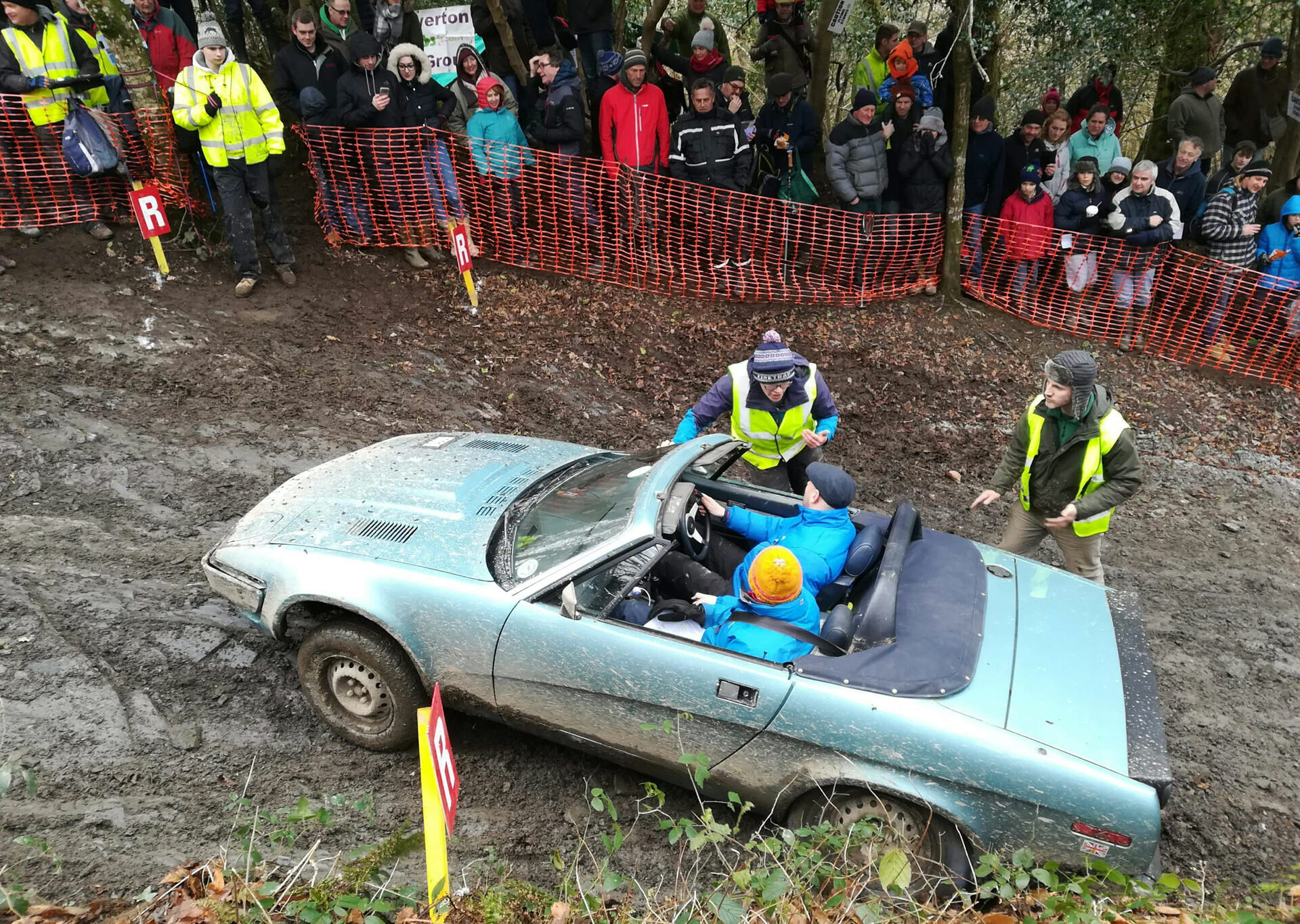
Nothing can ever quite prepare you for your first attempt at Simms Hill. I think. I was genuinely nervous of the thing, not helped by the hours of YouTube footage of scary fails I had watched beforehand, desperate to pick up tips.
The distraction of a competitor ahead of us failing the hill and showering us all with thick mud did nothing to calm my fear as I waited my turn. Heart thumping in my chest, I tried to take deep breaths and focus on smooth movements of the wheel and watching the hill ahead. “When you’re ready – GO!” boomed the voice of the start marshal, cutting cruelly through my concentration. “I’m not sure I’ll ever be ready” was the thought that ran through my mind briefly, but with a deep breath I eased out the clutch, tried to keep the revs down until forward motion was gained, and then firmly sank the accelerator pedal to the floor.
The only way to take Simms Hill is flat out. It is steep from the very beginning and you must be at maximum momentum as you fling the car round the right-hand ninety-degree bend, where it slews sideways in the mud. Then the fight is on to keep the TR heading in a straight line, whilst hugging the bank on the left, lined with hundreds of spectators all shouting and jeering encouragement. It is at this point that you are staring upwards at a 1 in 3 muddy slide with car-sized craters at various stages ahead of you. What is more, if you do lose grip enough to fail the section half way up, as we did, the car will start running backwards down the hill, despite the fact you are still flat to the floor in first gear! If failing the hill itself is not bad enough in front of hundreds of people, clapping in commiseration, then the escape road is just as difficult!
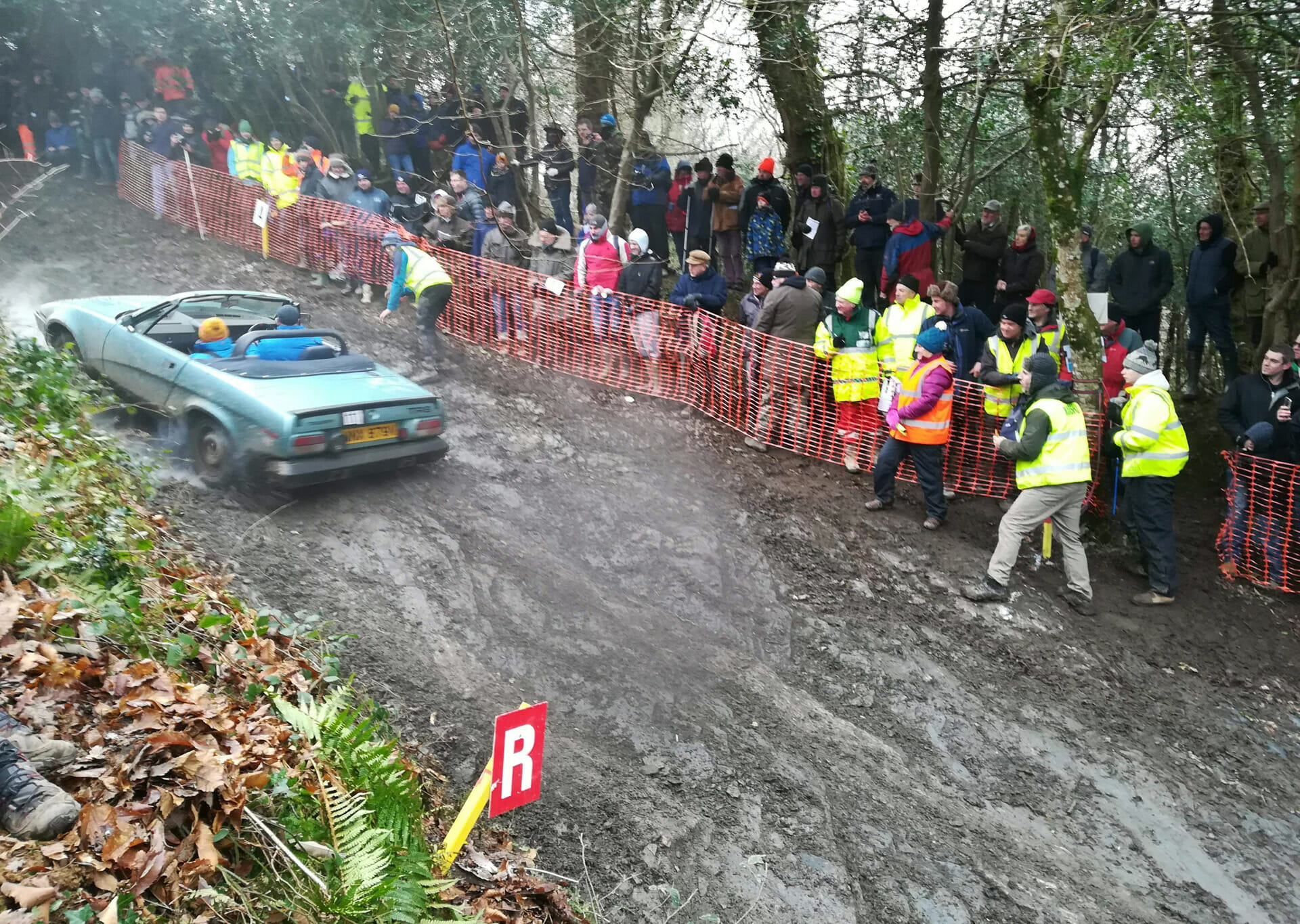
There is not much time to catch your breath. You cross the public metaled road and descend into woods for the penultimate section called Tipley. If Simms did not beat you, then this section is here for just one purpose; to shake, break, twist and shatter your car into submission to make doubly sure you deserve that finisher’s certificate. This section can only be described as horrendously rough, a true car killer.
We sat patiently and watched as car after car was towed backwards off it, many broken and smoking. I tried my best to protect the car but every relentless bang and thud on the underside of our plucky wedge seemed to take its toll. Amazingly we cleared the section, where others had failed horribly before us, but it came at a cost.
At this point the tyre had given up on the driver’s rear and had been ripped unceremoniously off the wheel. With the help of some passing bikers we got off the main track and set about changing the wheel for one of the two spares we were carrying. After some messing about with the air compressor that all hardened trials cars carry in the boot for fast inflation of tyres, we were back on the road, heading for the fourteenth and final section, Slippery Sam.

I had previous with this final section. Just a year previously had seen me fail this when a wheel came off the car, so I approached it this time with some trepidation! It was dark again by this point and the event had been delayed for us by needing to change a top hose and a couple of alternator belts along the way. It was just this one last hill between us and finishers victory.
It was foot to the fall, all out and determined, navigating around the car sized slabs of rock I slid the car up one then hopped over the next before finally, with a massive sideways slide, we crossed the section ends board and completed the 2019 Exeter Trial!

As for Duckhams part in all this? Well, the technology built up over a hundred years of leading-edge oil production was noticeable. Oil pressure was slightly higher, but much better maintained throughout the rev range. Oil consumption was down overall as well and although the detergents had caused some darkening of the oil, it was still noticeably green. The engine barely broke a sweat and will ride on now until the next event, the Lands’ End Trial over the Easter Weekend – see you there perhaps?



 Belgium
Belgium Denmark
Denmark Germany
Germany Greece
Greece Ireland
Ireland Luxembourg
Luxembourg Malta
Malta Netherlands
Netherlands Norway
Norway Poland
Poland Romania
Romania Russia
Russia Sweden
Sweden United Kingdom
United Kingdom Afghanistan
Afghanistan Jordan
Jordan Kuwait
Kuwait Lebanon
Lebanon Nepal
Nepal Pakistan
Pakistan UAE
UAE Malaysia
Malaysia Myanmar
Myanmar Singapore
Singapore Taiwan
Taiwan Thailand
Thailand Vietnam
Vietnam
